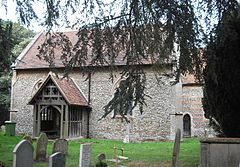Bradfield Combust
| Bradfield Combust | |
|---|---|
 All Saints Church |
|
| Bradfield Combust shown within Suffolk | |
| Shire county | |
| Region | |
| Country | England |
| Sovereign state | United Kingdom |
| Post town | Bury St Edmunds |
| Postcode district | IP30 |
| EU Parliament | East of England |
Bradfield Combust is a village in Suffolk, England, located on the A134 between Windsor Green and Great Whelnetham. The population is included in the civil parish of Bradfield Combust with Stanningfield.
According to Swedish Professor of English at Lund University, Eilert Ekwall, the meaning of the village name of "Bradfield" is "the wide fold" (syn. Bradefeld, Bradfelda, Bradefelda). "Combust" is derived from "Combusta" Latin fem. = burnt or burned; medieval syn. "Brent".
Before the Conquest, the manor was probably owned by Ulfketel, Saxon King of the East Angles, who gave this part of his manor to the monks of St. Edmund, while reserving the lordship.
The Domesday Book records the population of Bradefelda manor, including Bradfield St Clare and Bradfield St George. Bradefelda/fella existed before the Conquest. The book states that then (i.e. before the Conquest), as in 1086, there were fifteen villans and eighteen bordars; 'then' one slave, and in 1086 six slaves; and three free men. Over these men St. Edmund (the Abbey of Edmund the Martyr) had sake and soke with regard to every customary due. They were not allowed to sell their lands without the Abbot's say so. In the same place (i.e. Bradfield) other men had more rights: there were in 1086, as before the Conquest, nine free men who could sell their lands but the soke and service belonged to the Abbey or anyone who purchased the land. The Book also records that the church of this 'vill' owned ten and a half acres of free land for alms.
The name Bradfield Combust is traditionally said to have derived from an incident in the autumn of 1327, when an angry mob burned down Bradfield Hall at Bradfield, at the time the property of the Crown (a young Edward III) and managed by the Abbot of Bury St Edmunds. However, it is reliably asserted that a Bradfield Hall (the King's own hall) inside the Abbey at Bury St Edmunds was burnt down during that insurrection. Thus there were two Bradfield Halls and there arose a debate as to the naming of the village, and the circumstances surrounding it. The settlement is certainly known to have been called 'Bradefeld Combusta' in 1302/03. Thus the naming of the village cannot originally have been associated with the 1327 insurrection. It is reasonable however, to deduce that the name of Bradfield Combust (appearing certainly in the early 14th century, and in the 15th century synonymous with Brent Bradfield or Burnt Bradfield) does derive from some conflagration – but of what, when prior to 1302, and exactly where, is unknown.
...
Wikipedia

